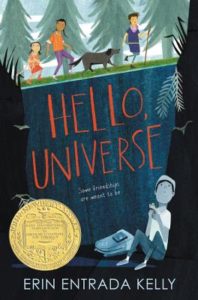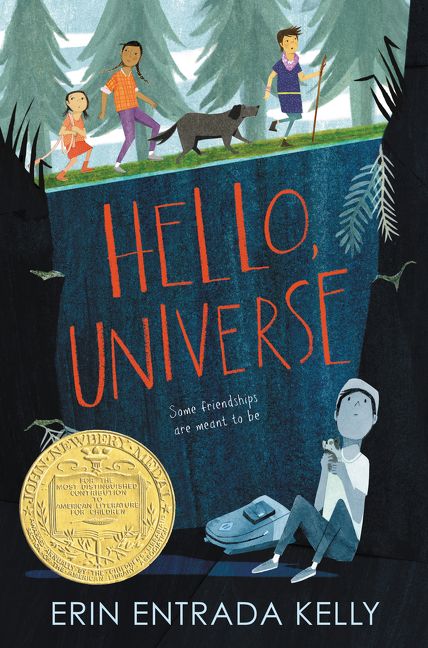craft review by LA Biscay
 Whether or not Erin Entrada Kelly used a prescribed form of story structure while writing her 2018 Newbery Award winning book, Hello, Universe, I could sense solid bones during my first reading. I giggled, I teared up, I enjoyed the characters’ journeys, and since the novel is told from four different POVs, I figured it would be a challenging study on story structure. With such detail to character and relationship (see our post on character relationships in Hello, Universe) I wondered if Kelly combined Character Arc with Story Structure.
Whether or not Erin Entrada Kelly used a prescribed form of story structure while writing her 2018 Newbery Award winning book, Hello, Universe, I could sense solid bones during my first reading. I giggled, I teared up, I enjoyed the characters’ journeys, and since the novel is told from four different POVs, I figured it would be a challenging study on story structure. With such detail to character and relationship (see our post on character relationships in Hello, Universe) I wondered if Kelly combined Character Arc with Story Structure.
Oh yes, she does.
Since most guides on Story Structure focus on the journey of one Protagonist, I needed to determine which of the four characters is the main protagonist. Virgil has 16 POV chapters, Valencia has 13 chapters, Kaori gets 8 chapters, and Chet gets 4. Virgil has the most, but not by much, so for assistance, I turned to K. M. Weiland’s blog, Helping Writers Become Authors She’s created a comprehensive 10 part series entitled, “The Secrets of Story Structure: Why Should Authors Care?” I highly recommend it.
Who is the protagonist?
In Part 2, Weiland writes, “Because your ability to convince the reader to keep reading is dependent on your Hook, it must be present as early as possible in your first scene.”
In Hello, Universe, Virgil opens the story, which means he is responsible for the Hook, and it’s right there in the second paragraph.
“All things considered, he should have been happy on the last day of school. The year was over. He should have been skipping home, ready to tackle the bright summer ahead. Instead he walked through the front door like a defeated athlete—head low, shoulders hunched, a sack of disappointment sitting on his chest like an anvil. [cue Inciting Event:] Because today, it was official: he was a Grand Failure.”
I’m hooked. I want to know why Virgil is so deflated and what that Grand Failure is all about.
In terms of the Inciting Event, Weiland says it can happen before the story opens or at any point in Act 1. It’s the framework for the story. For Virgil, the thing that made him a “Grand Failure” is that he let the entirety of 6th grade pass by without working up the courage to offer a simple “hello” to Valencia, a girl in his class. The main story question (plot) becomes whether or not he will be able to overcome his insecurities to say “Hello.”
The Key Event that sets everything in motion happens when Virgil texts Kaori for help with his Grand Failure.
If I wasn’t already convinced Virgil is the main protagonist, I would determine which character’s life is thrown into chaos around the 25% mark of the book. Yep, Virgil’s.
From Part 1 of Weiland’s Structure blog, we understand the 1st Plot Point must be “a change of surroundings, a personal turning point, the point of no return for the protagonist.” The 1st Plot Point happens at the end of the First Act, typically around the 25% mark. According to Weiland, “The first major plot point is something to which the main character must be able to react strongly and irretrievably.” (Part 4)
In Hello, Universe, the first major event that causes a strong reaction from Virgil happens in Chapter 16: the neighborhood bully, Chet, tosses Virgil’s backpack down a well. Virgil’s beloved pet guinea pig, Gulliver, is tucked inside the backpack. Aside from the fact that his best friend is now trapped inside a well, the event also delays Virgil from his current plot goal of reaching Kaori’s house to perform the ceremony that will bring him and Valencia together so he can say hello. Because that’s what Virgil wants, right? A chance to say “hello.”
But he already had that chance in the grocery store in Chapter 8, and he didn’t take it! What is wrong with this kid? Turns out, Virgil is dutifully performing his role in Character Arc, and using Character Arc is a great way to structure a novel.
Character Arcs
Weiland outlines this technique in her 14-part blog on “Creating Stunning Character Arcs.” In Part 1, “Can You Structure Characters?” she writes: “Plot and character are integral to one another. Remove either one from the equation, or even just try to approach them as if they were independent of one another, and you risk creating a story that may have awesome parts, but which will not be an awesome whole.”
In Part 3 of her Character Arc blog, Weiland discusses the protagonist’s Want vs. Need and how these two desires should be spelled out in Act 1. She writes, “The thing your character wants will almost always be something external, something physical.” Virgil wants to say hello to Valencia. It’s an admirable goal, and we want him to achieve it. But what he NEEDS is something far more complicated. He needs to overcome the Lie he believes. Virgil believes he is a Grand Failure.
Weiland discusses “The Lie Your Character Believes” in Part 2 of her Character Arc blog: “The Lie is a specific belief, which you should be able to state in one short sentence.” The Character’s Lie works its way into EVERY part of story structure, until the very end, when the protagonist no longer believes it.
The concept of the Lie is easy to get confused. Virgil believes he is a Grand Failure, and well, he sort of is, so how can it be a lie? Well, a “lie” is different from “THE Lie,” so if the term Lie trips you up, substitute Belief That Must Change Regardless of Whether It’s True or Not. Whatever Belief you chose for your protagonist at the beginning of your story, it must change by the end of the story.
Virgil is/believes he is a Grand Failure because of his inability to say hello to Valencia, but I suspect his Grand Failure is more complicated. Way back in Chapter 1, we learn that Virgil’s extroverted family members call him Turtle:
“Because he wouldn’t ‘come out of his shell.’ Every time they said it, a piece of him broke.” (p. 4)
Later, Virgil tells us,
“When they called him Turtle, it was like when Chet Bullens at school called him a retard. He knew his parents weren’t like Chet Bullens, but he also knew that they were poking fun at his shyness, just like Chet Bullens was making fun of the fact that Virgil was eleven years old and didn’t know his multiplication tables.” (p. 33)
Failure, failure, failure = Grand Failure. It’s going to take the entire book for Virgil to overcome all those failures. Kelly does a wonderful job of showing us, through backstory flashbacks, specific times the Lie/Belief developed: (1) the day Lola arrived and (2) how Virgil needs to go to the Resource Room for extra math help. Weiland would term these backstory moments the Ghost that created the Lie (Part 4.)
In a successful Story Structure/Character Arc combo, the events in Act 1 & 2 reinforce the Lie. Back in Chapter 8 in the grocery store, hilariously titled “Drama in the Freezer Aisle,” Kelly creates a moment in Act 1 that offers Virgil what he most desires: a chance to say “hello” to Valencia. She turns up in the freezer aisle at the same time as Virgil! It’s his chance to attain what he Wants, but instead, he hides behind his grandmother because the Lie is still too heavy for him to conquer.
“He couldn’t let Valencia see him now. Not when he didn’t know what to say or do. What if this was fate and he’d ruin it by being…well, himself? [i.e. a Grand Failure.]” (p.56)
All of these events happen in the First Act build-up to the 1st Plot Point, which brings us back to Gulliver ending up in the well. That event ends the First Act. Act 2 opens with Virgil’s reaction to the 1st Plot Point. He must make a choice, and it’s not an easy one. He isn’t an adventure-seeking kind of kid to begin with, but more importantly, HE’S AFRAID OF THE DARK!
Characters’ Fears: if your protagonist has one (they should), then they must face it. Remember Indiana Jones? His greatest fear was snakes, which is why he ended up in a pit of vipers!
We’ll return to Virgil’s fear and his decisions in spite of that fear in next week’s post. For now, think about your protagonist, what lie they believe, and what they fear. Those elements will help drive your plot. At its core, a plot is simply the actions your character takes. And those actions must be driven by character.
Action: What are the Ghost moments in your protagonist’s backstory that create the Lie?
Action: What opportunity does your protagonist have in the First Act to attain his Want and how does the Lie keep your protagonist from attaining it?
Action: What Fears must your character face?
LA Biscay writes children’s books and dances everyday, if only down the hall. As a teacher of Creative Movement, she enjoys assembling basic dance elements into unique combinations. It’s probably why she’s a fan of story structure! LA is an active member of SCBWI. She lives in the San Francisco Bay Area with her husband, children, super dog, and a brood of chickens that lay green eggs. Yep. Green eggs.


Several characters in Hello, Universe make decisions that have consequences later in the book. For example, in chapter 21, Valencia walks by the well where Virgil is stuck and covers it with a lid. What possible consequences does this action have?